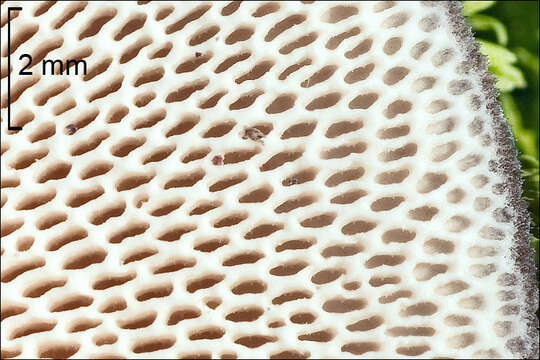Polyporus-brumalis_9

Description:
Polyporus brumalisWinter polyporeSlo.: zimski luknjiarDat.: Dec. 19. 2011Lat.: 46.34435 Long.: 13.56309Code: Bot_583/2011_IMG8267 Habitat: Light mostly broadleaf wood with scattered Picea abies, south oriented, relatively warm place, modestly steep mountain slope, cretaceous clastic rock (flysh) bedrock; humid, partly sunny, exposed to direct rain; average precipitations ~ 3.000 mm/year, average temperature 8-10 deg C, elevation 490 m (1.600 feet), alpine phytogeographical region.Substratum: fallen deciduous tree trunk, rotten but still partly in bark; possibly Fagus sylvatica. Place: Bovec basin, north of Mala vas, at the foot of Mt.ukla, 1.756 m (5.761 feet), East Julian Alps, Posoje, Slovenia EC Comment: Winter season and habitus of this observation speak in favor of Polyporus brumalis. However, spore dimensions and pore shape correspond better to Polyporus arcularious, which is a spring mushroom according to almost all references I found. Krieglsteiner (Ref.(3)) states that transition forms between both are frequent. According to Donk they are named Polyporus brumalis f. subarcularious, Donk, Medded. Nedl. Mycol. Ver. 18-20: 133 (1933). Index Fungorum considers this name as a synonym of P.brumalis. What is the latest word about somewhat ambiguous taxonomy of these two difficult to separate species is unknown to me. Interestingly the mushrooms where completely frozen when photographed, nevertheless after a day at room temperature they sporulated abundantly. Growing in a group of about 25 fruitbodies on a single about 4 m long log. Pileus diameter from 2.5 cm (one inch) to 6 cm (2.5 inch). Flesh tough, when dry very hard. SP abundant, light gray-whitish (oac893). Cap brown-gray (oac 639), pores surface beige (oac793), stipe brown (oac743) with some white mycelium at the base. Smell indistinctive.Spore dimensions: 7.2 (SD = 0.4) x 2.6 (SD = 0.2) micr., Q = 2.77 (SD = 0.21), n = 30. Ref.:(1) A.Bernicchia, Polyporaceae s.l., Edizioni Candusso (2005), p 459. (2) M.Bon, Parey's Buch der Pilze, Kosmos (2005), p 314. (3) G.J.Krieglsteiner (Hrsg.), Die Grosspilze Bade-Wrttembergs, Band 1, Ulmer (2000), p 602. (4) R.Phillips, Mushrooms, Macmillan (2006), p 297. (5) A.Bernicchia, Polyporaceae s.l., Edizioni Candusso (2005), p 457 (data of P.arcularius).
Included On The Following Pages:
- Life (creatures)
- Cellular (cellular organisms)
- Eukaryota (eukaryotes)
- Opisthokonta (opisthokonts)
- Nucletmycea
- Fungi (mushrooms, lichens, molds, yeasts and relatives)
- Dikarya
- Basidiomycota (basidiomycete fungi)
- Agaricomycetes (Mushroom-Forming Fungi)
- Polyporales
- Polyporaceae (bracket fungi)
- Lentinus
- Lentinus brumalis
This image is not featured in any collections.
Source Information
- license
- cc-by-nc-sa
- copyright
- Amadej Trnkoczy
- photographer
- Amadej Trnkoczy
- original
- original media file
- visit source
- partner site
- Flickr Group
- ID


